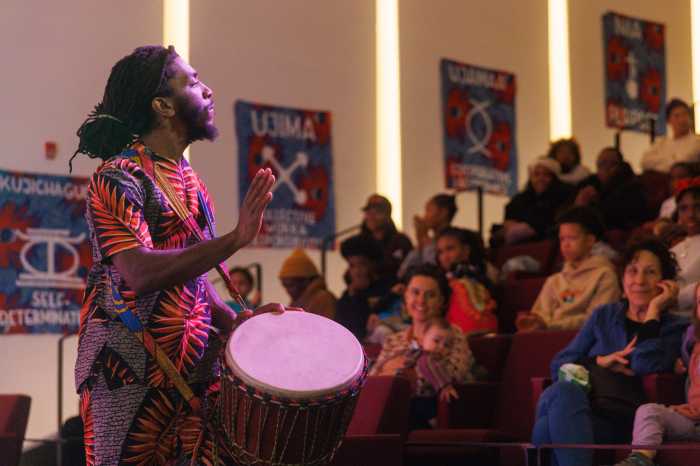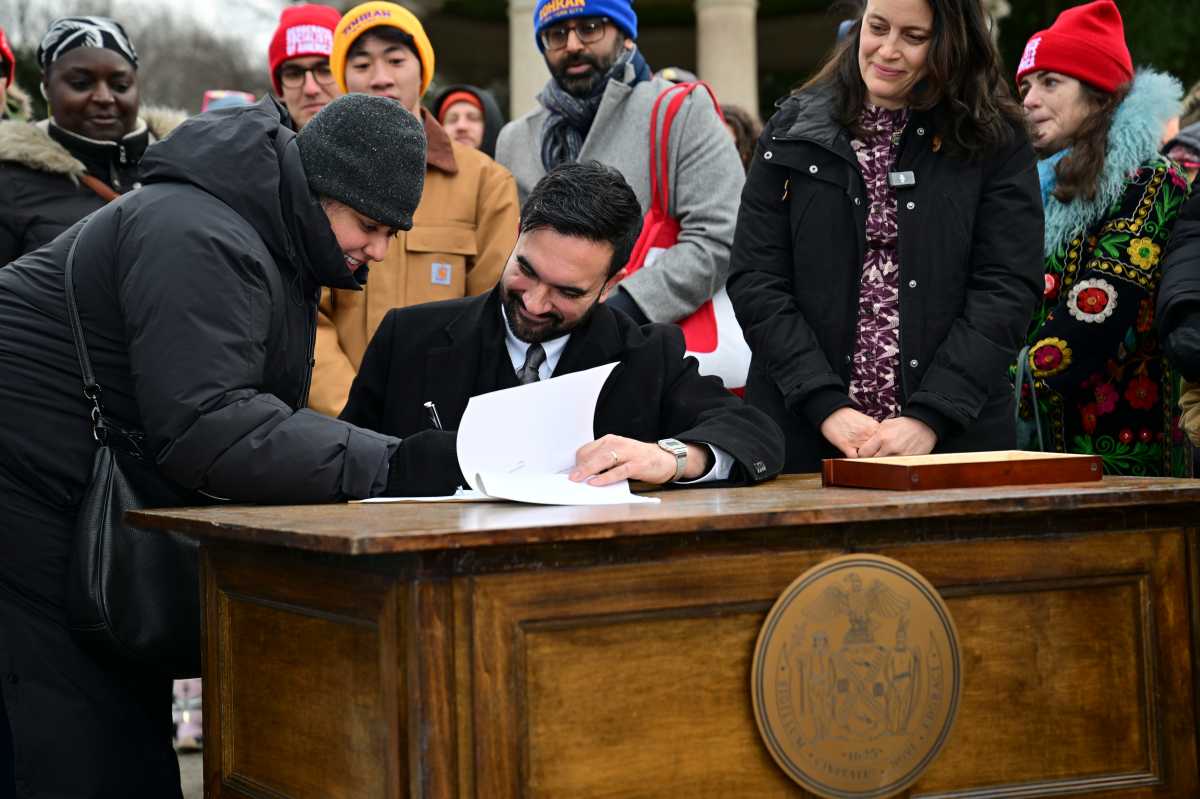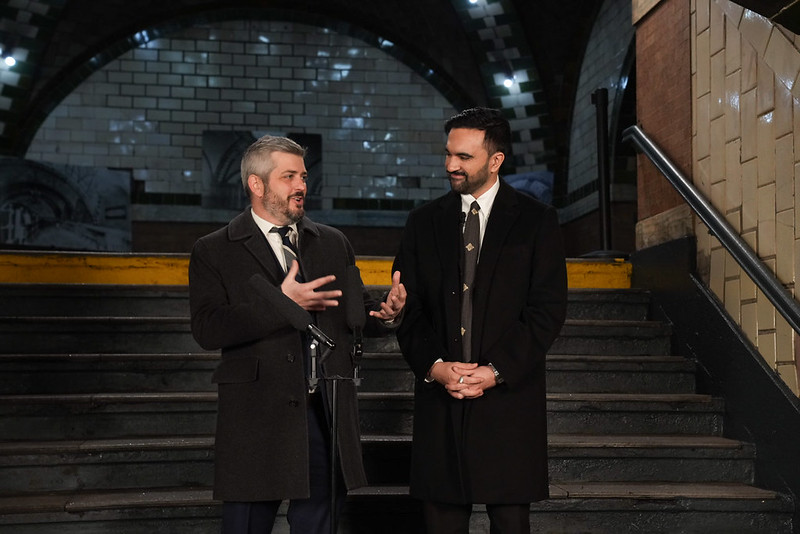Laurie Anderson has been called a visual
artist, composer, poet, photographer, filmmaker, electronics
wiz, vocalist and instrumentalist. But she’s really best described
as a metaphysical reporter.
For her 2001 solo show, "Happiness," Anderson stayed
with an Amish family in Pennsylvania, went whitewater rafting
with Buddhist monks and worked at a McDonalds in downtown Manhattan,
not far from Ground Zero. Her current show, "The End of
the Moon," which opened at BAM Harvey Theater on Feb. 22,
was inspired by her two-year stint as artist-in-residence at
NASA.
Although Anderson never traveled into outer space, she did visit
the Jet Propulsion Laboratory in Pasadena, Calif.; the Johnson
Space Center in Houston, Texas; the Space Telescope Science Institute
in Baltimore, Md.; and the Kennedy Space Center in Cape Canaveral,
Fla. Anderson watched training sessions, took notes and asked
questions. But "The End of the Moon" has as much to
do with America’s space program as "King Kong" has
to do with the animal rights movement.
For Anderson, all reality is personal. And not all of life is
reality.
Her experiences at NASA serve mostly as a launching pad for her
own thoughts on life on Earth and beyond. The stage in "The
End of the Moon" is set with burning candles, an armchair
and a small screen displaying the cratered surface of the moon.
Anderson, wearing a black pantsuit with sequin trim, has a voice
that is gentle, compelling and sexy. Her stories are ironic,
self-deprecatory, funny and mystical. She is accompanied by low
but strident background music. When Anderson doesn’t speak, she
plays her signature violin, creates striking images with a handheld
camcorder and mixes sound on a PowerBook laptop computer.
For the average performer, "The End of the Moon" would
be pretty high-tech, but for Anderson, who has previously employed
gadgets like the Talking Stick, which produces sounds when touched,
and eyeglasses that pick up and echo sounds, this show is somewhat
bare bones.
There’s a mournful, brooding quality about "The End of the
Moon." Perhaps Anderson’s performance has been influenced
by the tragedy of the space shuttle Columbia or the tragedy of
the war in Iraq, which she clearly opposes. But even Anderson’s
jokes seem sad.
At one point she tells her audience that life is bad art with
too many writers. Later in the evening she remarks that people
don’t stutter at the end of words because by then it’s too late
to be afraid.
Of course, she doesn’t stutter, and it’s hard to believe Anderson
was ever afraid. Her entire 90-minute performance is one sure-footed
step after another. It is filled with confidence and a sense
of purpose.
Anderson has a long relationship with BAM, beginning with "United
States I-IV" which was staged in 1983. She was later part
of the Next Wave Festival in 1989 ("Empty Places")
and 1999 ("Songs and Stories from Moby Dick"). Her
return is nothing less than triumphal.
Anderson may not know where she or the nation or the world is
going. But she certainly doesn’t believe in standing still. And
she’s happy to take everyone else along for the ride.
Back to School
In the days before chat rooms, the best way to spread malicious
gossip was over tea at a friend’s house. The British 18th-century
playwright Richard Brinsley Sheridan used this human propensity
for backbiting to great effect in one of his most popular plays,
"The School for Scandal," now at the Gallery Players
under the direction of Henry Wishcamper.
As a comedy of manners, "The School for Scandal" returned
to the basic style of the Restoration period, but many critics
have noted that Sheridan’s play has a moral content not present
in works of 17th-century England. Names like Lady Sneerwell,
Joseph Surface and Sir Benjamin Backbite clearly demonstrate
Sheridan’s disdain for a certain type of individual.
With his brilliant depiction of the manners of his day, Sheridan
created a polished satirical comedy that loses none of its charm
as a period piece in contemporary times. The Gallery Players,
true to their robust treatment of the classics, present "School
for Scandal" with all its stylish trimmings – from Carrie
Mossman’s simple but eloquent set to Sarah Rizza’s elaborate
costumes, complete with 6-inch-high wigs and wired skirts.
Unlike many directors, Wishcamper has resisted the temptation
to tinker with the classics. He has chosen instead to let the
play’s dramatic structure and accessible humor speak for themselves.
If a moral does emerge from all the backbiting and prevarication
in this comedy, it is that true love triumphs. The principal
couple is Sir Peter Teazle (Lawrence Arancio), an aging bachelor
who has married the young and attractive Lady Teazle (Lael Logan).
Their union, however, is threatened by Joseph Surface (Matthew
Humphreys), a young man-about-town who flirts with Lady Teazle
in an attempt to get closer to Peter’s ward, Maria (Alexis Hyatt),
even though she is in love with his brother, Charles (Joshua
Bevans).
If Joseph is hypocritical and avaricious, Charles is profligate
and reckless and Joseph takes advantage of his brother’s weaknesses
while successfully concealing his own. Peter foolishly prefers
Joseph over Charles thanks to Joseph’s insinuations.
In the meantime, Sir Oliver Surface (Wilbur Edwin Henry), Charles
and Joseph’s wealthy uncle, returns from India determined to
find out the true character of his two nephews, whom he hasn’t
seen for many years.
Around these basic plot lines, Sheridan weaves a web of misunderstandings,
misinformation and miscalculations perpetuated through disguises
and eavesdropping. There are a number of hasty concealments behind
screens and doors. At the same time the acid-tongued Lady Sneerwell
(Brooke Delaney) and her minions keep up an intermittent commentary
on the goings-on of these denizens of high society.
In a uniformly excellent cast, Arancio stands out for his ability
to remain dignified and sympathetic despite his foolish attachment
to a younger woman of dubious moral quality. Humphreys is admirable
for his unmitigated rascality. And Henry is the perfect Dutch
uncle (transported across the English Channel) who mixes a healthy
dose of wisdom and reason with a generous helping of self-interest.
At a time when rich old men frequently woo and win younger women
and opinion has replaced genuine news, "The School for Scandal"
offers a curiously modern lesson. The Gallery Players prove to
be exemplary teachers.
Laurie Anderson’s "The End of the Moon" is performed
March 5 at 7:30 pm and March 6 at 3 pm at the BAM Harvey Theater
(651 Fulton St. at Ashland Place in Fort Greene). Tickets are
$20, $30 $45 and $50. For tickets and more information, call
(718) 636-4100 or visit the Web site at www.bam.org.
The Gallery Players production of "The School for Scandal"
plays through March 6, Saturday at 8 pm and Sunday at 3 pm at
the Gallery Players (199 14th St. at Fourth Avenue in Park Slope).
Tickets are $15, $12 seniors and children under 12. For more
information, call (718) 595-0547.

























